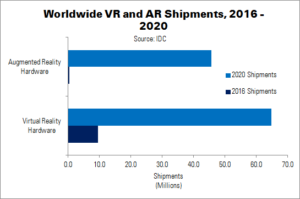The two most hotly-anticipated virtual reality headsets – the HTC Vive and Oculus Rift – have been launched worldwide and are now shipping to (a few) lucky customers. Analysts are very excited about the technology, releasing heady predictions of millions of shipments and billions of dollars of revenue this year.

Back in February, Gartner forecast that 2 million VR headsets would be shipped this year, increasing to 5 million in 2017 and 8 million in 2018. That might sounds low to people dealing with mature, high-volume markets like smartphones and PCs, but it is respectable for a new and expensive technology. Google Glass is not a wholly accurate comparison – the product was never available to the public – but is perhaps the closest measure that we have. Only about 40,000 units were sold by the end of the first year of Glass sales.
According to Gartner’s forecast, there will be about 25 million headsets being used by the general public, in total, in 2018. Again, this is a fairly low figure compared to, say, graphics cards. In an interview with PC World, research director Brian Blau noted that Gartner is “cautious that [the VR market] won’t take off as fast as other technologies like smartphones”. As I discussed in a recent article (Will Gaming Outsell Pornography for VR?), price is a major barrier to adoption, as is the need for a powerful PC.
In the above article, I said that gaming was one of the largest potential markets for VR. CCS Insights (which is more positive than Gartner, forecasting 24 million device sales in 2018 alone) calls it ‘the low-hanging fruit’ for VR – and, certainly, the Oculus Rift and HTC Vive are seeing high levels of adoption amongst gamers. CCS also notes, however, that applications such as video and user-generated content will also drive adoption.
Even more optimistic than CCS Insights, however, is the latest forecast from IDC. The firm predicts that VR device sales will skyrocket in 2016, reaching 9.6 million units sold and hardware revenues of $2.3 billion. Note that this also includes sales of ‘bring-your-own-display’ devices like Samsung’s Gear VR (but not devices that lack electronics, like Google Cardboard), which IDC calls ‘Screenless viewers’. The firm also divides the market into ‘Tethered Head-Mounted Displays’ (i.e. Oculus Rift) and ‘Standalone HMDs’ (i.e. Microsoft Hololens). Augmented reality hardware will ramp up over the following years. By 2020, the combined AR/VR device market will surpass 110 million units.
IDC has predicted that first-generation tethered VR devices, from Oculus (Oculus Rift), HTC (HTC Vive) and Sony (PlayStation VR), will drive more than 2 million shipments this year – again, with gaming as the ‘killer app’. Augmented reality, for which dedicated devices are more difficult to develop, will take longer – existing products like smartphones will continue to be trialled as ‘stand-in’ AR viewers.
| Worldwide Augmented and Virtual Reality Hardware Shipments and 5-Year CAGR | |||
|---|---|---|---|
| Product Category | 2016 Shipments | 2020 Shipments | 5-Year CAGR |
| Virtual Reality Hardware | 9.6 | 64.8 | 183.8% |
| Augmented Reality Hardware | 0.4 | 45.6 | 189.8% |
| Source: IDC | |||
It is not just market watchers that are enthusiastic about virtual reality’s prospects. HTC – which certainly has an interest in promoting the technology – thinks that the VR market will outgrow smartphones by volume within four years. Wang Tsung-ching, head of HTC Vive China, points to the fact that smartphones outgrew personal PCs within five years as his ‘proof’ (although of course smartphones were a standalone and low-cost product, unlike VR headsets – TA). The firm has also established a $100 million fund to nurture new VR companies (HTC Signals Future is in VR).
Tom Mainelli of IDC brings up a point that must be dealt with by VR HMD makers this year: the supply chain. Both the Oculus Rift and HTC Vive have been affected by shipment delays in the weeks since their launch. Oculus cites an ‘unexpected component shortage’ as the reason, but that will be of little comfort to those early adopters who placed an order in January, only to now be seeing delivery dates as far away as late June, in some cases. Considering such postponed delivery, removing shipping charges (Oculus Rift is Delayed – subscription required) does seem like the least that the firm can do.
HTC has not been quite so poorly affected – only the newest orders have been hit with set-backs. Again, a June delivery date is quoted. ‘Payment processing’ problems, though, have impacted some pre-orders placed in February, and these headsets will be delivered in May. As the Bard said, “The course of true love never did run smooth” – the same could apply to any popular technology product launch! This is the life of an early adopter, folks…
So, yes, 2016 will be the year of virtual reality – but to achieve the critical mass required to be a true success will take a lot more effort.
Analyst Comment
I continue to be impressed with the creativity of VR app developers. Where else can you watch a man fight music from a classic ’90s RTS game? http://tinyurl.com/jpm2s5o. (TA)

